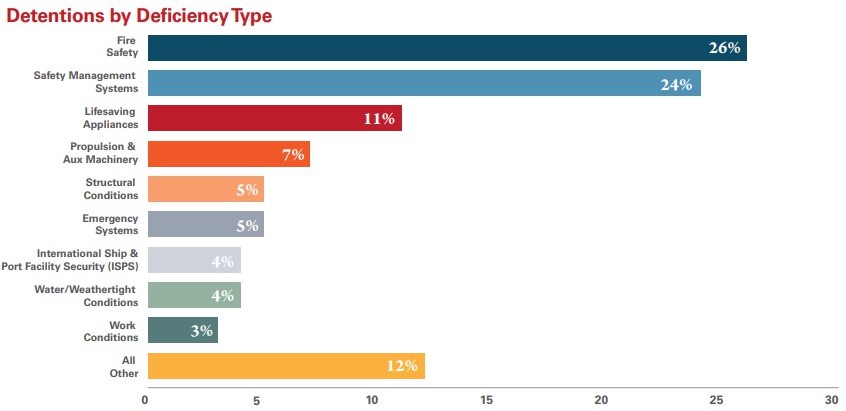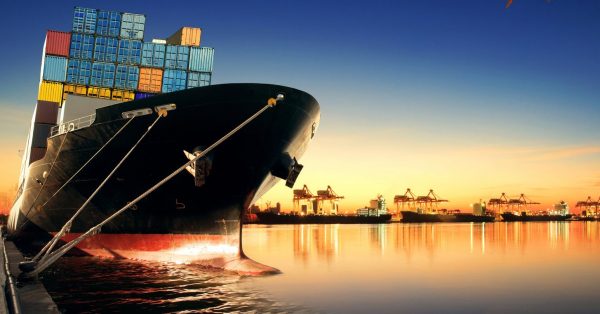The US Coast Guard’s Office of Commercial Vessel Compliance announced the release of the U.S. Port State Control Annual Report for 2021. USCG reported that the total number of ships detained in 2021 for environmental protection, safety, and security related deficiencies increased from 57 to 63.
Highlights
- In 2021, the Coast Guard conducted 8,663 SOLAS safety exams with a total of 63 detentions.
- The annual detention rate decreased from 0.77 percent to 0.73 percent.
- The three-year rolling average detention ratio decreased from 1.02 percent to 0.87 percent.
- Data this year shows the number of detentions related to fire safety decreased while those related to lifesaving systems increased over last year.
- The number of recognized organizations that were associated with detentions increased from five in 2020 to seven in 2021.
Vessel Arrivals, Exams, and Detentions
In 2021, a total of 10,945 individual vessels, from 81 different flag administrations, made 73,974 port calls to the U.S. 8,663 PSC exams were conducted. Despite the ongoing global pandemic, these exam numbers increased over the 2020 total of 7,383 and have surpassed the 2019 pre-pandemic total of 8,622. The total number of ships detained in 2021 for environmental protection, safety, and security related deficiencies increased from 57 to 63.
Flag Administration Performance
In 2020, the Coast Guard combined safety and security compliance performance for all program measures. Flag Administration performance for 2021 dropped slightly with the overall annual detention rate decreasing from 0.77% to 0.73%. Additionally, the three-year rolling detention ratio decreased from 1.02% to 0.87%. Barbados, Cook Islands, Liberia, Malta, and the Philippines were removed from the Targeted Flag List this year.
Detention and Association Appeals
In 2021, the Coast Guard received a total of twenty-four appeals. Ten appeals challenged the overall merits of the detention. For those merit appeals, one was granted, seven were denied, and two are still being adjudicated at the time of this report.
In addition to receiving appeals contesting the overall merits of a detention, we also receive appeals requesting the removal of a party’s association to a detention. For those parties appealing their association with a detention, fourteen were received. Of those, seven were granted and the other six were denied.

QUALSHIP 21 and E-Zero Programs
Once again, the USCG considered the impact of COVID-19 on international shipping when determining QUALSHIP 21 (QS21) eligibility. However, no changes were made to the eligibility criteria based on the reduced number of vessels trading with the United States in 2021.
The QS21 program ended calendar year 2021 with an impressive 3,661 vessels enrolled. In 2020, we welcomed three additional flag administrations into the program with five losing their QS21 eligibility. For 2021, one flag administration lost its eligibility while five additional flags became eligible. The program welcomed the flag administrations of Barbados, China, Liberia, Malta, and the Philippines for becoming QS21 eligible this year.
The E-Zero program focuses on environmental stewardship and worldwide compliance with international environmental conventions. By the end of 2021, 220 ships received the E-Zero designation.

Enhanced Exam Program
Beginning in 2021, the Coast Guard initiated the Enhanced Exam Program (EEP). This program, similar to the Concentrated Inspection Campaigns (CICs) carried out by port state control MoUs, is intended to increase focus on specific aspects of ship safety on a quarterly basis. This increased focus may vary due to the implementation of new regulations, deficiency trends, or other PSC program interests.
The goal of the EEP is to generate meaningful data on exam points of interest, while limiting the additional workload of the PSCOs. The information collected can then be considered for evaluating current policy effectiveness, and determine if adjustments need to be made in the future. In 2021, PSCOs carried out enhanced exams as part of routine port state control exams on ballast water compliance, fire and abandon ship drills, and MARPOL Annex VI.
The enhanced exams conducted resulted in 41 ballast water, 8 fire and abandon drills, and 13 MARPOL Annex IV deficiencies. Through the ballast water EEP, additional clarity was gained on the methods that vessels are using to maintain compliance. It was established over a 3 month period that 56% of the ships surveyed used a Coast Guard approved ballast water management system, while 22% of ships possessed an extension letter. It is also worth noting that during the fire and abandon ship drills, deficiencies occurred in less than 1% of exams conducted.
































































